In the writings of A. A. Milne, the Hundred Acre Wood is home to many beloved characters. LEGO invites us all to visit these childhood friends in LEGO Ideas 21326 Winnie the Pooh. Based on an idea submitted by fan Ben Alder in March of 2019, this set will be available to LEGO VIP members starting March 18, with general availability following on April 1st. For US $99.99 | CAN $139.99 | UK £89.99 you’ll get Pooh’s home and five exclusive minifigures. Read along as we look for honey-dipped surprises, keeping a watchful eye out for any stray Heffalumps. (Spoiler alert: There are no Heffalumps in this set.)
The LEGO Group provided The Brothers Brick with an early copy of this set for review. Providing TBB with products for review guarantees neither coverage nor positive reviews.
The box and contents
The packaging for this set follows the “Adult Collector” theme. That means a minimalist black background, understated logos, and a colorful stripe along the bottom of the box. It also means that the mandated age range for this set is “18+”. While I don’t know of too many people who take these age ranges too seriously, it does seem like an odd choice to put this set so far out of reach of younger builders. There’s nothing here that is more complex than you’d see in a comparable 8+ playset. On the plus side, the graphics are very clear as to what you’ll be getting. Pooh’s home, a signpost, and the five characters are all displayed to good effect.

The back of the box shows the interior of Pooh’s house, with the characters enjoying a casual spot of tea. Along the right edge is a quick summary of the LEGO Ideas process, as well as two insets showing Pooh enjoying some honey and reading, and a third inset showing a schematic of the house. The line drawing includes the dimensions of the house – 9″/24 cm tall by 8″/22cm wide.
This is a hinge-top box, making the presentation of the contents a little more interesting than usual. Two sticker sheets and the perfect bound instruction manual are loose-packed underneath seven numbered part bags.
The 160-page instruction manual thankfully departs from the previous all-black formatting seen in “Adult Collector” sets. The first few pages feature some background on the Winnie the Pooh stories, an interview with idea-man Ben Alder, and a spotlight on the LEGO build team who translated Ben’s concept into the official set.
Another note on the lighter colors: LEGO recently announced they were abandoning the black backgrounds in the printed materials going forward. I’m very much in favor of this change, as the black-background instructions caused me some grief in the past. These, by comparison, are very easy on the eye and a lot easier to follow.
The parts
There are several rare parts and new recolors included in this set, and I’ll call out some as we explore the build. However, of particular note are twenty-four Coral branches in green, and two 45 degree elbow bricks in medium nougat. Both are new colors for those parts, and are exclusive to this set.
Not unique, but still pretty new are these 1×1 modified angle plates. There are four of them in brown, a color which also appeared Minecraft set 21169 The First Adventure.
This medium nougat 2×4 rounded tile is also scarce, having previously only appeared in three 2021 Mario sets. The light grey 1×1 round flower plates were formerly limited to a 2020 Employee Exclusive: 4002020: 40 Years of Hands-on Learning – LEGO Education. There are also some rarer colors for other tiles, making this set a great parts pack for fans of stud-less decoration.
As is common for Ideas sets, there are a few new printed parts. My favorites this time around are 9 (eight plus a spare) 1×1 round tiles with bees printed on them. They’re almost as cute as the Koi tiles in the 80107 Spring Lantern Festival set.
Also of note is a new honey pot print, with Pooh’s “Hunny” labeling on one side. There are four of these scattered around the set.
Finally, we also get a 1×6 brown tile showing the name that Pooh lives under.
In addition to the printed parts, there are also a number of decals. This set comes with two sticker sheets, both of which are packed loose in the box. Normally at this price point I’d expect to see the stickers and instruction manual packaged together in their own parts bag to prevent damage in shipment. Sadly that isn’t the case here, and one of my sticker sheets arrived pretty roughed up around the edges. The sticker designs look good, though, with callouts that add important details like Christopher Robin’s initials and the “ring also” note for the front door. The second sticker sheet is printed on metallic foil paper, a nice reflective surface for Pooh’s mirror. The foil sheet also has a map of the Hundred Acre Woods, although the opaque printing there completely obscures the reflective surface.
The build
The build starts from the ground up, literally in this case. The first bag of parts contains the Pooh and Piglet minifigures, a small sign pointing the way to the Hundred Acre Wood, and the base onto which Pooh’s house and tree will be built. Pooh gets a brick-built balloon, which, if you prop the string on the ground, looks more like an oversized lollipop to me. LEGO has released better looking minifigure balloons in the past – I wonder why they didn’t go with one of those here.
The sign is a quick build, but has a lot of charm nonetheless. A “Hunny” pot sits under a sticker-decorated arrow. Like the Sesame Street lamppost, this small build feels like something collectors will want to keep together, even if the rest of the set is later broken up for custom building.
The base of the set reveals one of the main play features – the sides of the house are mounted on hinges to allow easy access to the interior.
Usually LEGO likes to spread out minifigures across the entire build experience. This isn’t the case here, as the remaining three characters all show up in bag two.
Pooh’s home is bracketed by some large shrubbery, constructed from some interesting SNOT techniques. Medium nougat brick represents the bark of the attached tree, with some nicely integrated arches giving things a very organic feel.
A closer look at the completed shrub shows another bit of inventive building. Minifigure “action stands” are attached to leaves, which in turn are clipped into bars built inside the shrub. This allows for the leaves to hug the curves of the greenery. The only complaint is that the clip-bar connection to the baseplate isn’t very firm, and trying to attach the figure stands is a lot harder than it should be. It might be easier for some builders to attach the stands to the clips while they’re more exposed. Also, trying to twist the leaf/stand combo to best match the curves of the bush can also lead to dislodged parts, so be careful here.
The interior of Pooh’s home is broken into three main sections: The entryway, a bedroom, and a tea room. Both the bedroom and tea room are constructed early on, so I grabbed a couple of photos before details were obscured by the roof and walls. There’s a small demerit earned in that the curtains sit directly on the bed. It’s not the best look. It’s not super obvious, but once you see it, it’s hard not to keep noticing it. The footprint of the interior is so small, though, that I don’t see any obvious way around this if you keep the curtain/bed designs as they are. (And both look pretty great as isolated components.)
At this point the tea room has a removable comfy chair, table with “Hunny” pot and teacup, and the base of the wood-burning stove. There’s also a stickered 2×2 round tile with bee imagery.
Outside, there’s a nice little technique to add some window sills and flowers. The studs on the 1×1 round plates and leaves fit into the gaps in the fence. The back of the house also gets a small ladybug visitor. That printed 1×1 round tile first appeared in the 2021 Collectible Minifigures Ladybug Girl figure.
Before the roof goes on, you can peek inside and see just how compact this build is when the walls are shut. There is zero space wasted, and each room is built so that there’s no overlap into the other. Is Pooh’s home like the Tardis and just seems bigger on the inside? Ultimately it doesn’t matter – the hinged walls let you have your cake honey and eat it too.
The entryway has a small gap down the center for minifigures to move through, but each wall has a focus as well. One side has a mirror (remember that foil sticker from earlier?) and umbrella stand. On the opposite wall is a tea service and a map to the Hundred Acre Wood hung on the wall.
Now that the interior is more or less together, building shifts to the tree. Lots and lots of medium nougat elements are used here; a boon for fans of that rarer color.
The thick tree trunk that runs through the bushes has a great curve to it. The whole thing is attached to a small T-bar that you can see in an earlier photo. The top of the root lines up with a 2×2 round attached to the house’s structure.
The upper branches of the tree also have some complex building lurking under the bark. Technic connections are used to tilt out the branches at an uncommon angle.
Once the top of the tree is in place, the roof goes onto the house. This avoids being a repetitive build by the use of three different shades of 1×2 cheese slope tiles and integrating some 1×2 jumper plates to hold leaves. You have to look at the instructions pretty closely if you want to match the designer’s intent. The roof also gets a smokestack that aligns with the wood stove in the tea room.
Now that the roof is on, the attic is also filled up. Over Pooh’s bed are two sealed jars of honey, as well as another open pot. Over the tea room are a gold 1×1 heart tile and a box of “Poohsticks”. That box has two stickers – a label on the front and the initials “CR” on the back. (For Christopher Robin, one would presume.) It’s also worth noticing that the woodstove now has a smokestack leading up to match the one on the exterior. They’re not physically connected, but the illusion that they are is pretty solid.
In the upper branches of the tree you’ll find two beehives. Each is ringed by a protective force of four 1×1 printed bee tiles. I like the connection method used here. The transparent minifigure accessory clips move the bees out a bit from the hive, leaving a better impression that they’re flying around.
The last major steps are putting the leaves on the tree. This, unfortunately, is a bit of a drag, as you’ll be building six identical copies of the same assembly. And each assembly involves making four identical copies of the same branch layout. That’s the price you have to pay, I suppose, for a wealth of useful parts, including those swanky new green coral pieces. The build here is also a little fragile. The leaves need to be attached to the hinge plates so that the rod connection on the end of the coral doesn’t pop the bricks loose. I found that rotating the branches slightly to the side and then bending the branches into a bowl shape was easier/more stable than the approach the instructions show (seen in the middle photo, below.) Either way, though, there are plenty of leaves and coral to make the tree seem very lush. And things are designed so that the beehives are still visible, too.
The final bit of building is putting this book together. (Okay, it’s technically the start of bag seven’s steps, but I saved it for last.) There are three stickers here – a cover showing Pooh and his honey, an interior page showing Pooh and his red balloon, and a bookplate showing this particular volume belongs to “Ben A.” If you’ll recall, Ben Alder submitted the idea that became this set, so this is a really nice Easter egg tribute/signature.
The finished model
The completed model offers two very different viewing/play experiences. The first, with the wings of the house opened, creates a nice interior diorama to place the characters into. There are plenty of details to enjoy. The only real weakness is the lack of leaves on this side of the tree.
The the house closed up, the feel of the display changes. This looks a lot more like an establishing shot from one of the stories, as you approach Pooh’s home. The leaves on the roof match the foliage on the tree, tying the scene together and making it feel like a real location. From this angle you can also see a small brick-built, poo-shelled snail hiding in the bushes.
Approaching from the font, you can see the round dark tan tile leading up to the front door. There’s also a campfire and log for sitting on, and some mushrooms capped with unprinted red BB-8 heads. The “closed house” version looks great from every angle, allowing collectors to display it in multiple orientations.
The minifigures all fit well into the exterior spaces, and look like they’re having a good time. Well, maybe not Eeyore. The front door design is also worth calling out. There’s a blue 1×1 cone hung on a wrought iron spool (a minifigure whip in black), and a golden knocker on the tan-tiled door. The Mr. Sanders tile looks pretty good in place, too.
The interior layout is obviously spacious enough for whatever scene you want to construct. Pooh’s movable chair helps expand the playset feeling, keeping the figures from looking like they’re just hanging out in an unrelated space.
The minifigures
All five of the exclusive minifigures included in this set feature new molds. They range from the pretty great (Tigger) to the meh (Piglet), to the immobile (Eeyore). But even the weaker likenesses are still very recognizable, and as a group they are sure to brighten a lot of people’s day.
Winnie The Pooh
The star of this set, Winnie the Pooh comes with his signature red balloon, ready to try and capture some honey from the upper branches of his home. His new molded head looks pretty good, although it seems slightly oversized to me. He sports a dual-sided torso print and dual-molded arms. The printed graphics feel a little flat, but do match up well to Pooh’s animated look.
One small problem is revealed when Pooh raises his arms – thanks to the dual “high rise” shirt on the torso’s front and back, a side-view makes it look like Pooh needs to have a very stern word with his tailor. It’s also worth mentioning that the “tummy print” on the red base torso doesn’t match all that well with the colors on the rest of Pooh’s body. The red base plastic shows through just enough to wreck the illusion. This is a problem it feels like LEGO has struggled with for years; maybe in the future we’ll see dual-molding used as a workaround.
Thanks to an extra bucket handle, bee tile, and hand-clip, you can transform Pooh into a very unlikely crossover superhero. (I can totally see this being the plot of the next Ryan Renyolds Green Lantern movie. Can’t you?)
Piglet
Piglet has a new head mold, short pink legs, and dual-sided torso print. He comes wrapped in a red scarf, a nice nod to the source material. In my opinion, Piglet’s head is the weakest design of the bunch, his nose looks a bit squished, and the ears make it too tall compared to the other characters’ noggins. In fact, Piglet’s head is actually larger than Pooh’s. “I’m a very small animal with an enormous melon,” he was heard to say.
Tigger
Tigger bounces in with a new head mold and snazzy printing on his legs, arms, and torso. He also has a new print for the removable tail accessory. Having just arrived in the Hundred Acre Wood, Tigger is carrying a brick-built bindle made from a white sack (a color only seen in Build-a-minifigure part selections at LEGO stores) connected to a brown rod. I think LEGO did a good job matching Tigger’s animated likeness, as the character is instantly recognizable. Ben’s original idea for Tigger was a brick-built creation, but I think LEGO made the right choice to convert Tigger into a minifigure.
Rabbit
Rabbit’s minifigure is cast in bright light yellow, and has a new head mold and new torso print. It’s interesting to note that LEGO added in “cut in” graphics on the torso to suggest a more accurate pear-shaped build for Rabbit, a technique usually seen on female minifigure designs. Rabbit comes with a carrot for snacking, using the newer three-leaf plant as the topper, rather than the two-prong stem that is usually used for the greens.
Eeyore
Eeyore is an entirely new mold, with our oft-downtrodden friend sitting on the ground. He has a removable ribbon for his tail, but otherwise is cast as a single immobile piece. The original Ideas submission had a slightly more adorable brick-built Eeyore, but again I can see why LEGO opted to go with a figural approach. This version has Eeyore scaled to better fit in with his friends, and we all know Eeyore doesn’t need more reasons to feel like an outsider. Despite his lack of articulation, he’s my favorite minifigure in this set. (And not just because I identify strongly with Eeyore in real life. That’s totally a coincidence.)
Conclusion and recommendation
I think there’s a lot to like about this set. While some (myself included) might have preferred character designs based on the original E.H. Shepard illustrations, there’s no denying that LEGO did a solid job in capturing the current Disney likenesses. Five exclusive figures, a wealth of interesting and rare parts, and a fun and interesting building experience all earn this set high marks. A cost of $100 US for 1265 pieces gives a price-per-part ratio of just under eight cents, which is also a pretty nice perk. The compact design makes this an easy set to display, and the hinged walls are a good way to let the interior be seen. The shortfalls of this set are also found in the compact design. The inside of Pooh’s house is crammed with details, some of which are pretty obscured once the model is assembled. But that’s fairly minor, and since some of the furniture is removable you can set up a larger “inside the house” display if you want to. This feels like a set that will be a hit with both LEGO and Disney fans, so if you fit into either of those categories, consider picking this one up!
LEGO Ideas 21326 Winnie the Pooh will be available for LEGO VIP members starting March 18 with general availability on April 1 from the LEGO Shop Online for US $99.99 | CAN $139.99 | UK £89.99. It will also be available via third-party sellers on Amazon and eBay.
The LEGO Group sent The Brothers Brick an early copy of this set for review. Providing TBB with products for review guarantees neither coverage nor positive reviews.
Check out our full gallery of images












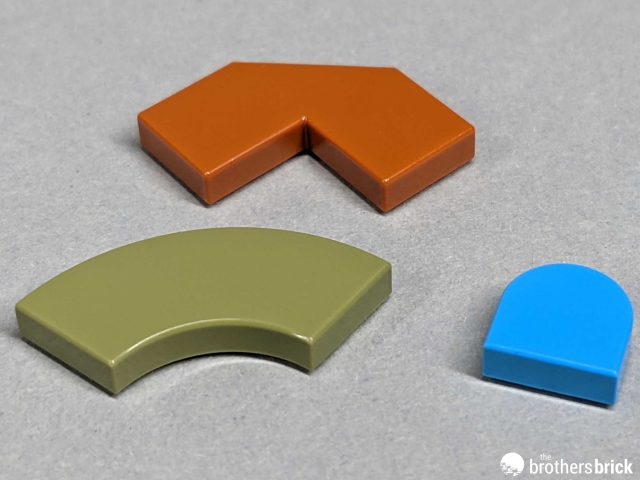
















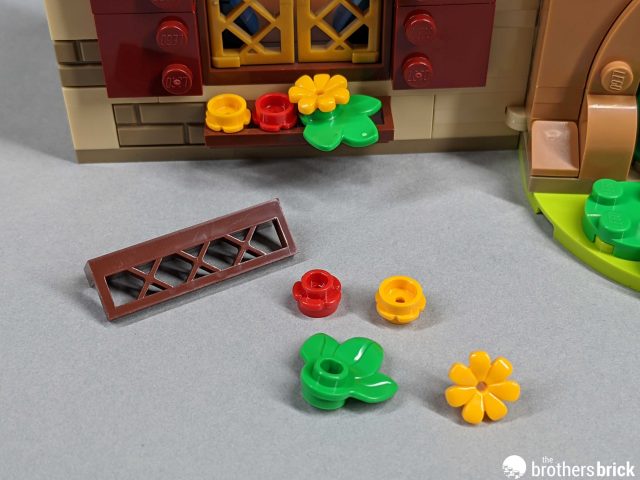














































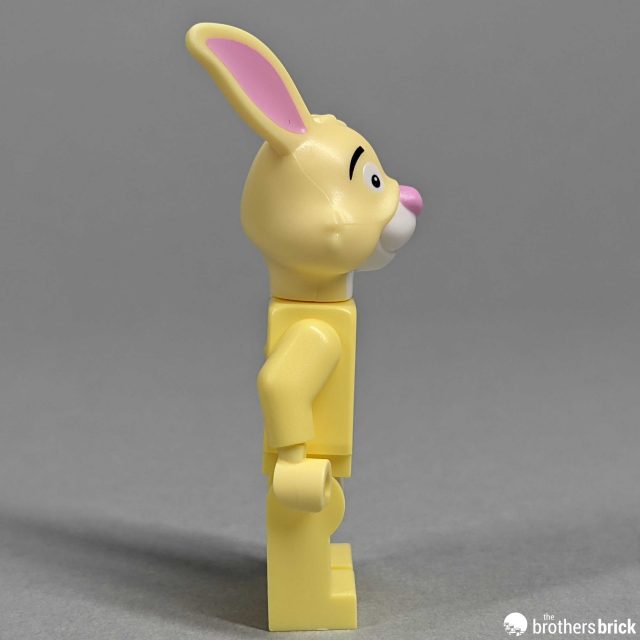















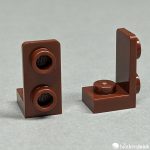



















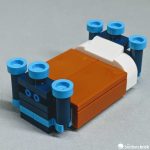






















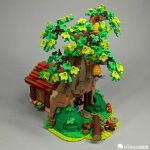
































This is a GREAT set. It’s really nice to see LEGO taking a good suggestion and sprucing it up quite a lot (As opposed to taking an incredibly intricate model and then downgrading it).
Piglet’s head really is unfortunately large. And if they wanted to give Pooh his “proper” big red balloon (Which is my guess as to why they didn’t use the much-better balloon piece from the collectible minifig line), why is his balloon still much too small for that? And yeah, that torso on him doesn’t quite work, but it works enough. Totally could be dual-molded in the future.
Speaking of pieces from the collectible minifigs, why does LEGO never use the medium-size legs? I’da given Pooh a set of those.
Of course, I will be buying this set. I do love it. But can someone please tell me where Christopher Robin is? He’s kind of important.
I’ll have to add my own.
@Michelle – I’m actually kind of torn on if a Christopher Robin figure would have worked or not. To be in scale, he’d have to be the size of the old Technic figures…seeing him the same height as Pooh (or, even worse, Piglet) would wreck the illusion pretty quickly. The subtle inclusion of the “CR” initials on the back of the box of Poohsticks helps address his absence a little, at least.